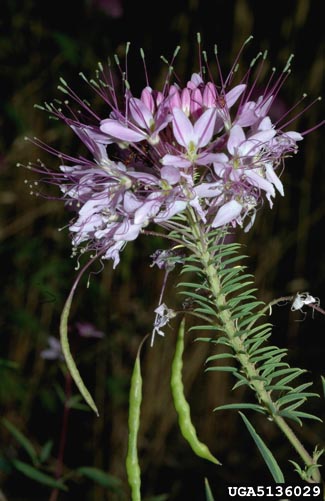Rocky Mountain Beeplant

Common Name(s):
Rocky Mountain Beeplant
Bee spiderflower
Stinking-clover
Toothed spider-flower
Scientific Name:
Cleome serrulata Pursh
Scientific Name Synonyms:
None Known
Symbol:
CLSE
Description:
Life Span: Annual
Origin: Native
Growth Characteristics: Rocky Mountain Beeplant is an erect, branched annual that grows to about 3 ft. tall in our area. It is in flower from July to August, and reproduces from seed.
Flowers: Flowers are about 1/2 inch long and atop long pedicels. The flower has 4 attractive petals, and the stamens are longer than the flowers, giving the spikes a fuzzy appearance. Dozens of bright, pink to purplish flowers are crowded into rounded or rather elongate spikes.
Fruits/Seeds: Fruit is a narrow capsule up to 2 inches long that bears several to many dark, ovoid seeds.
Leaves: Leaves are in groups of three’s on long petioles. The margins may be entire or have very small teeth.
Stems: A tall stem surrounded with short narrow 3-lobed leaves
Ecological Adaptions:
Rocky Mountain Beeplant is often found in wastelands, and in lower mountains. It is frost tender. It can grow in semi-shade (light woodland) or no shade.
Soils: Rocky Mountain Beeplant is often found on sandy soil. It prefers light (sandy) and medium (loamy) soils and requires well-drained soil. The plant can survive in a range of soil pH levels.
Associated Species: Big Sagebrush, gambel oak, penstemon
Uses and Management:
Rocky Mountain Beeplant has little to no value as forage for livestock and wildlife.
As its common name suggests, bees are attracted to the flowers and this adds to its appeal as an ornamentals.
Lewis and Clark collected Rocky Mountain beeplant in South Dakota in August of 1804; at that time the plant was new to science.
Rocky Mountain Beeplant has many medicinal uses. It was highly used by Native Americans, and was probably cultivated and grown by them. They would allow the plant to produce seed when it was growing wild in the cornfields in order to ensure a supply the following year.
The seed can be harvested and eaten raw or cooked. It can be dried and ground into a meal then used as a mush or mixed with flour to make bread etc. The seedpods can also be cooked. An infusion of the plant is drunk in the treatment of fevers and stomach disorders. A poultice made from the pounded, soaked leaves has been applied to sore eyes. A decoction of the leaves has been used as a body and shoe deodorant.
A black dye is obtained by boiling down the whole plant. It is used as paint for decorating pottery. The young plants are harvested in mid-summer, boiled well in water, the woody parts of the plant are removed and the decoction is boiled again until it becomes thick and turns black. This thick liquid is then poured onto a board to dry in cakes and can be kept for an indefinite period. When needed it is soaked in hot water until the correct consistency for paint is achieved.
The hardened cakes of dyestuff can be soaked in hot water and then eaten fried.

